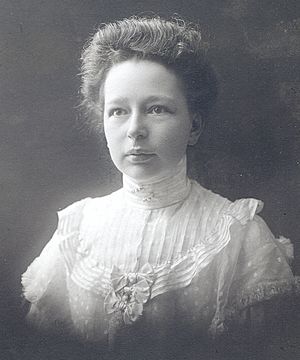Elisabeth Tamm facts for kids
Elisabeth Tamm (born June 30, 1880, in Julita, Sweden – died September 23, 1958) was an important Swedish politician and a strong supporter of women's rights. She was known in the Swedish parliament as Tamm i Fogelstad, which means "Tamm of Fogelstad."
Contents
Who Was Elisabeth Tamm?
Elisabeth Tamm grew up on the Fogelstad manor in Julita. She was the oldest daughter of August Tamm, who was also a politician and a landowner, and Emma Åkerhielm. Elisabeth and her sister Märta were taught at home by a governess. Their father also taught them how to manage a large estate.
Elisabeth attended lectures at Uppsala University. However, in 1905, she inherited Fogelstad Manor from her father. She decided to manage her family's estate instead of continuing her studies. Elisabeth Tamm never married.
Because her father was involved in politics, Elisabeth became interested in politics and the growing women's movement from a young age.
Elisabeth Tamm's Political Journey
As an unmarried woman who owned property, Elisabeth Tamm was allowed to vote in local elections. This was thanks to a law passed in 1862. When women gained the right to vote in municipal (local) elections in 1909, she became very active in local politics.
- She served as the deputy chairman of the Communal Council of Julita in 1913.
- She became the chairman of the Communal Council in 1916.
- From 1919 to 1930, she was a member of the city council's board of directors.
- She led the women's political group Frisinnade kvinnors riksförbund in Södermanland from 1922 to 1931.
- She was the municipal communal speaker for Julita from 1933 to 1936.
Becoming a Member of Parliament
In 1921, a big change happened in Sweden: women were finally allowed to be elected to the national parliament. Elisabeth Tamm was one of the first five women to achieve this. She joined Nelly Thüring, Agda Östlund, and Bertha Wellin in the Lower Chamber. Kerstin Hesselgren was elected to the Upper Chamber.
Elisabeth Tamm focused on issues important to women. She worked for equal pay for women and for women to be able to hold all official jobs. This goal was addressed by a law called the Behörighetslagen, passed between 1919 and 1925.
She started her political career with a Liberal party. However, from 1924, she became an independent politician. She served as a MP until 1924. After leaving parliament, she continued to be active in local politics. She retired from politics in 1936 due to health reasons.
Working for Women's Rights
Elisabeth Tamm was a strong voice for women's rights. She wrote articles for important women's rights newspapers like Tidevarvet and Vi kvinnor. She also helped start and pay for Tidevarvet and a Norwegian women's magazine called Kvinnen og Tiden, which was published from 1945 to 1955.
In 1925, she started the Kvinnliga Medborgarskolan, which means 'Citizen School for Women'. This school was located on her estate, Fogelstad, and she served as its chairman. The school helped women learn about their rights and responsibilities as citizens.
Elisabeth Tamm also cared deeply about the environment. In 1940, she co-wrote a book with Elin Wägner called Fred med jorden, which translates to "Peace with Earth." This shows her interest in ecology and protecting our planet.
Images for kids



